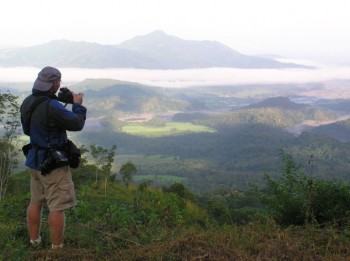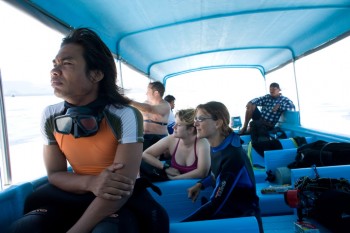The 18th session of the UN World Tourism Organization (UNWTO) General Assembly, which concluded on October 8th 2009, highlighted “The enormous importance of [tourism] for job creation, trade and development.” The UNWTO also said that tourism, which is a multi-billion dollar a year industry, “provides more than 75 million direct jobs worldwide, offers fast entry into the workforce, particularly for youth and women in urban and rural communities, accounts for 30% of the world’s exports of services (1 trillion US$ a year) and up to 45% of the total export of services in developing countries.”

Sustainable community-based heritage and nature tourism means supporting businesses developed and operated by local stakeholders. Partnering with local stakeholders and skills transfer are critical to the long-term success of any project.
According to researchers from Yunnan University:
“Marketing is the fatal weak point to most failed CBET projects. Far too many inexperienced rural communities have attempted to operate independently of the tourism industry and have consequently failed. The major reason for failure was their inability to access the extensive promotion and marketing systems upon which tourism depends.”
The Hummingfish Foundation’s goal is to help CBET programs in succeed in reaching their potential customers through the use of compelling marketing tools and channels. To link a CBET destination with a potential tourist, it is vital to have an arsenal of powerful photographic images and present them in a way that can convey the power and beauty of community-based heritage and nature tourism assets.
THF projects create many valuable skills as well as a central photographic archive with thousands of high-quality images, which can be used to promote CBET destinations through a variety of marketing tools. Projects will create a legacy of photographic and design excellence, which will be synonymous with tourism in there.
On the one hand, you have potential destinations for community-based heritage and nature tourism. On the other hand, there is a multi-billion dollar a year tourism industry.
How to connect the two? How to bridge the gap between CBET assets and nature-loving tourists?
The short answer is compelling imagery, well presented.
This is the mission of The Hummingfish Foundation, to connect the dots between community-based heritage and nature tourism assets and heritage/nature loving tourists.
Of all the industries that a nation can possess, tourism is the one industry that relies on compelling imagery well presented to sell.
You can sell fisheries, oil or timber without powerful photographs, but not tourism.
Environmental protection
The Hummingfish Foundation believes that economic opportunity must go hand in hand with environmental protection. To protect nature’s unspoiled natural resources, we must add value to them for local shareholders through sustainable community-based ecotourism. To achieve this goal, it is essential to brand the destination and present it’s beauty to the potential ecotourists in a stylish way. It is also essential to work with local shareholders to help them develop an understanding of the ecotourism market and build the capacity to profit from it in a sustainable way.

Tourism is a multi-billion dollar a year industry and community-based ecotourism can provide strong incentives for local shareholders who rely on natural resources to survive. Adding value to unspoiled natural resources through sustainable community-based ecotourism, diversifying income and creating new job opportunities for generations to come, creates a strong incentive for local shareholders to protect the very natural resources on which their livelihoods depend.
Research by the Australian Tourism Commission suggests that 80% of its tourism is nature focused, including birding. Birds and bird watching tourism are not to be overlooked as a potential source of tourism dollars in other countries. The Australian Tourism Commission also says that 54 million Americans participate in bird watching activities and 24.7 million.
Americans participate in birding tourism. The Royal Society for the Preservation of Birds in the UK has 1 million members. Bird watching enthusiasts are eco-friendly travelers who contribute hundreds of millions of tourism dollars annually.
PADI, which is the largest dive organization, has some 15 million licensed scuba divers in the world and it has been estimated that by the end of 2005, diving activities will have generated about $1.2 billon US Dollars annually. According to the World Resources Institute, dive tourism grows at a rate of 7% per year. Revenue generated by diving, snorkeling and coral viewing has been estimated at 10-20 times higher than income from fishing in reef areas.
Australia’s Barrier Reef is estimated to be worth over US$1.67 billion a year. In the Maldives, divers spend US$2.3 million a year on shark dives – estimated at 100 times more than the export value of the shark meat.
So it is clear that sustainable community-based ecotourism is a vital tool in the fight to protect the earth’s dwindling unspoiled natural resources. The Hummingfish Foundation can help to facilitate this business model, which generates revenue and protects natural resources by adding value to them in an unspoiled state. By showing the beauty and wonder of nature in a stylish and professional way, we can inspire potential ecotourists to go visit a destination, therefore giving a financial interested to local shareholders to protect that natural resource.
Relief of poverty
According to the United Nations World Travel Organization, “poverty alleviation has become an essential condition for peace, environmental conservation and sustainable development, besides being an ethical obligation in an affluent world, where the divide between poor and rich nations seems to have increased in recent years. According to the UNDP 2006 Annual Report, 2.5 billion people live on less than US$ 2 a day. Despite a growing world economy many people in developing countries are not reaping the potential benefits of globalization.

The potential for tourism to play a significant role in the alleviation of poverty is increasingly recognized by international bodies and national governments. Its geographical expansion and labor intensive nature support a spread of employment and can be particularly relevant in remote and rural areas where many of the poor live. UNWTO statistics show the growing strength of the tourism industry for developing countries. In 2005, international tourism receipts for developing countries (low income, lower and upper middle income countries) amounted to US$ 203 billion. Tourism is one of the major export sectors of developing countries, and is the primary source of foreign exchange earnings in 46 of the 49 Least Developed Countries. World Wildlife Fund (WWF) says that tourism is the world’s largest employer, accounting for more then 10% of the world’s GDP. Even in the United States, where the concept of national parks was born, ex-president Jimmy Carter’s decision in 1980 to protect a huge chunk of Alaska as wilderness provoked such anger that people in that state lined up to throw bottles at his image. But today, the state earns $1 billion annually from tourism, mostly nature tourism.

Community-based ecotourism projects are excellent ways to create jobs and income for local shareholders. In the Maldives, divers spend US$2.3 million a year on shark dives – estimated at 100 times more than the export value of the shark meat. In Bali, Indonesia, there is a community-based dive tourism project in the town of Amed, where local shareholders profit from dive tourism and have also seen an increase in fisheries, due to the protection of a healthy marine environment. Profits from the dive industry are distributed to the community via the local fisherman’s association and the entire community is very protective of the marine environment for which their livelihood relies.
Research by The International Ecotourism Society (TIES) reveals that ecotourists are likely to be higher spenders on their holidays than ‘ordinary’ mass tourists and high-spending, nature-loving, responsible tourists are undoubtedly an attractive option for governments looking for ways of earning foreign exchange.

